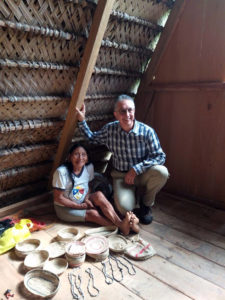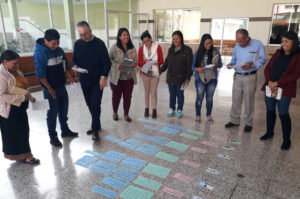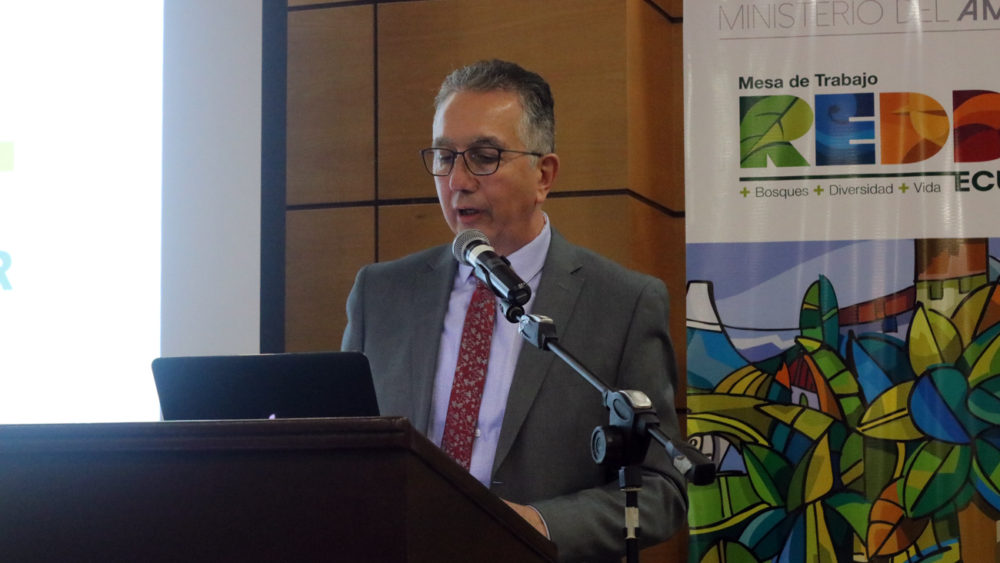 David Romo is a professor at the Universidad San Francisco de Quito and Director of the Tiputini Biodiversity Station.
David Romo is a professor at the Universidad San Francisco de Quito and Director of the Tiputini Biodiversity Station.
He has been a member of the REDD+ Working table for the second and third periods, representing the USFQ, and the academic sector. On this occasion, we interviewed him to learn about the scope and benefits of participatory spaces in which issues related to the environment are analyzed.
- What is the REDD+ Working Table, how is it formed and what is its objective?
The REDD+ Working Table is a space for the contribution of civil society in which, in a participatory, consensual and respectful manner, we can contribute to the management of Ecuador in relation to the implementation of policies and projects aimed at reducing deforestation.
- What are the most relevant issues that have been prioritized in the Third Period of the REDD+ Working Table?
During this period, there has been a strong focus on projects that will be financed by the contributions received by Ecuador, such as the REDD+ Ecuador Payment by Results Project. When we started with the REDD+ work in the country, we had to create a series of commitments regarding the reduction of deforestation in our country.
Photographs: Courtesy of David Romo
Description: Guiyero Community, Block 16
This required us to develop not just policies, but processes and technologies to measure our progress. Being pioneers and also having demonstrated a sustained reduction in deforestation, we receive contributions from abroad.
During this period, in addition to supervising the implementation of projects, we seek to influence the development of other lines of action with the objective of guaranteeing compliance with safeguards and promoting that these opportunities reach more actors, and from my position, which is in academia, to try to promote research.
- Why is it important to create participatory spaces and processes that are related to forest conservation issues?
It is easy to state that nature belongs to everyone, that forests belong to everyone, that protected areas belong to everyone. It is very difficult to take responsibility and seek that this common good is well managed. When something belongs to everyone, it is easier to think that we can all simply use that resource. For this reason, REDD+ strategies are aimed at promoting better treatment of resources that do NOT belong to everyone.
The objective is that with good management, the tendency to exploit what belongs to “everyone” can be gradually abandoned. Bio-entrepreneurship projects give priority to working with the communities so that by having their own resources, they can reduce the propensity to deforest communal areas and indirectly reduce the risk of illegal logging in protected areas.
- How do you evaluate the participation of the REDD+ Working Table during the construction of the proposal and the Start-up Workshop of the Payment by Results Project?
Having been a member of the Second Table, at the start of the third phase, I was very concerned because we were under the distancing rules due to the COVID-19 pandemic. The ProAmazonía team, and especially Magdalena Muñoz, did a phenomenal job because now we are more organizations, we had to train ourselves to use virtual technologies, which were new for most of the participants. Something very valuable was the leveling course, in which people new to the REDD+ environment had the opportunity to “level up” in knowledge about the processes and scopes of the Working Table.
- What are the goals and scope of the REDD+ Working Table in this third period and in 2021?
We have just approved our work plan. Rather, I would like to emphasize here that we have had a small change that I am sure will yield excellent results. For each sector, two representatives have been chosen and it is expected that small working groups will be created to deal with specific issues. This is a way to accomplish more things in less time. During the year we have four meetings in total, with the possibility of extraordinary sessions; however, the actions usually require shorter times. This will be easily overcome with this methodology.
- What have been the achievements of the REDD+ Working Table so far? Especially during the second period, the stage from which you are a member.
The greatest achievement we have had so far is the high level of participation and that many of the members, including representatives from remote communities, have been able to participate and use the technology appropriately.
- What are the expectations of the members of the REDD+ Working Table regarding the implementation of REDD+ in the coming years?
Expectations are always very high. There are people who still do not understand very well how this space works and want to settle specific issues that affect their organizations. Personally, I hope that we can contribute with training processes, which is something that we were already doing when using the REDD+ Working Table space, to present successful experiences.


Photographs: Magdalena Muñóz
Description: Archive Images – Closing Meeting of the Second Period of the REDD+ Working Table, July 2019
 Español
Español English
English
